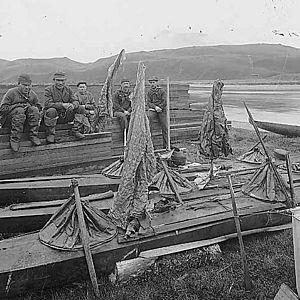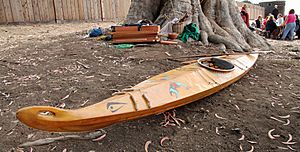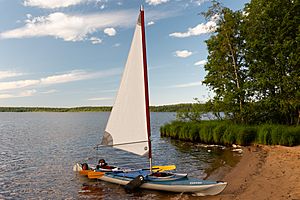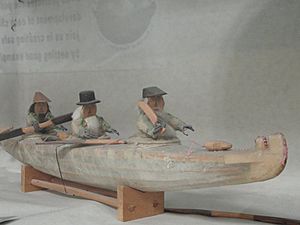Aleutian kayak facts for kids

The baidarka or Aleutian kayak is a special type of boat. The word "baidarka" comes from the Aleut word iqyax. It is made of soft skin, like animal hides or strong fabric, stretched over a stiff frame.
The native Aleut people, also known as Unangan, first designed these boats. They lived in the Aleutian Islands, which are surrounded by rough waters. They needed a way to travel and hunt on the sea.
Since there were not many trees in the Aleutian Islands, the Aleut people used driftwood for the boat frames. They covered these frames with the skins of sea mammals. They made two main types of baidarkas. One had a covered deck and was used for hunting. The other was open and could carry goods and people between islands.
Today, modern baidarkas are often foldable. They have frames made of aluminum alloy and skins of PVC fabric. Some even have inflatable parts for safety and better performance. You can also add sails, rudders, and fins to some designs.
Contents
What's in a Name?
The word "baidarka" is a Russian name for the Aleutian style of sea kayak. Early Russian settlers in Alaska gave it this name. They added the small ending "-ka" to the word "baidara." A "baidara" was another, larger boat used by the Aleuts, similar to an Umiak.
A Look Back: Baidarka History
Before the Russians arrived, most baidarkas had one opening for a single paddler. There were also some with two openings. When Russians came to hunt fur animals, they greatly influenced the design. This led to the creation of three-opening kayaks.
These three-person boats likely had one person paddling and steering from the back. The person in the front would use a atlatl (a throwing board) for hunting. The hunt leader would sit in the middle, directing the group.
Ivan Veniaminov, writing from Atka Island in 1840, described these early kayaks. He said:
- "The baidarkas of today are not as perfect as those of the past."
- "Back then, skilled paddlers could make them so fast that birds could not outrun them."
- "They were so narrow and sharp-keeled that they could not stand upright without a paddler."
- "They were also so light that a seven-year-old child could easily carry them."
How Baidarkas Are Designed
A special part of the baidarka is its forked bow, which looks like a split front end. These boats were very light and easy to steer. Aleut women carefully sewed seal skin over the frame. The frames were made only from driftwood, bone, and animal sinew. This was because no trees grew in the Aleutian Islands.
Aleut men treated the baidarka as a living being. It was considered bad luck for women to touch the boats once they were finished.
The men designed the baidarka frames to be light, fast, and flexible. They tied the wooden parts together with complex knots made from strong animal sinew. Unangan women prepared sea lion skins. They sewed these skins onto the frames using bone needles and a special waterproof stitch. When out at sea, men carried repair kits for emergencies. For the Unangan people, these sea kayaks were like spiritual beings and were vital for their survival.
From a young age, Unangan boys learned how to use the baidarka. You can find drawings of the Iqyax (Baidarka) online.
Baidarkas Today

In recent times, George Dyson is often recognized for bringing the baidarka back into popularity. He did this through his company, Dyson, Baidarka & Company. Dyson and his boats were featured in Kenneth Brower's book The Starship and the Canoe. Dyson himself wrote a book called Baidarka in 1986. His baidarkas are made from new materials like aluminum for the frame and coated polyester fabric for the skin.
Another person who helped revive the baidarka is David Zimmerly. He is an ethnographer, someone who studies cultures. Zimmerly has recorded the history of baidarkas and the people who used them. In 1983, he published articles in "Small Boat Journal" that showed how to build a baidarka.
Builders like Sergie Sovoroff kept the tradition of making skin-on-skeleton boats alive in the 20th century.
See also
 In Spanish: Baidar (embarcación) para niños
In Spanish: Baidar (embarcación) para niños




